Entries in Popular Culture (53)
Fortnite and coronavirus
In my fourteen years of pandemic lecturing, I frequently use the old Booz, Allen warning that socially distanced home workers in a pandemic could "lose the Internet."
Here's exactly what that means. Imagine an Internet scenario comparable to a fusion of Michael Jackson's death and Black Friday online sales. During the pandemic, parents are slaving over their computers, trying to do their work from home. Or one parent is working while another is trying to re-watch The Irishman on Netflix. Or The Mandalorean on Disney+. And Bryce, bored as Hell because schools are all closed, boots up the PS4 to play Fortnite (again) with friends.
Now imagine this scenario being replicated tens of thousands of times -- simultaneously -- in your own community. Now imagine that scenario magnified nationwide, to millions of homes.
Crashing game servers are the least worrisome problem. Crashing Internet service providers are the real concern.
We have no Earthly idea what will happen to the Internet if and when this scenario becomes a reality. It's a question that has not been asked since 2009. Now, one would imagine that the Internet is a far more resilient utility, with all these multiple carriers. But there is something called the Last Mile. Last Mile carriers are essentially that: telecommunications carriers who handle everybody's (or almost everybody's) common Internet traffic at one point or another within a community. From Wikipedia:
The last mile is typically the speed bottleneck in communication networks; its bandwidth effectively limits the bandwidth of data that can be delivered to the customer. This is because retail telecommunication networks have the topology of "trees", with relatively few high capacity "trunk" communication channels branching out to feed many final mile "twigs". The final mile links, being the most numerous and thus the most expensive part of the system, as well as having to interface with a wide variety of user equipment, are the most difficult to upgrade to new technology. For example, telephone trunklines that carry phone calls between switching centers are made of modern optical fiber, but the last mile is typically twisted pair wires, a technology which has essentially remained unchanged for over a century since the original laying of copper phone cables.
So now you understand the problems that can arise when Fortnite meets Netflix meets work from home plans. And since every home in America will probably be using the Last Mile (unless you have fiber to the home or satellite Internet), the potential to "lose the Internet" is there. It's just that no one knows how, when, or how bad this could be. Adding to the problem is that home Internet connections fall under the category of "best effort." Many of us would argue that "best effort" is an oxymoron. Emphasis on the "moron" part. Corporate and government networks, by contrast, usually have Service Level Agreements with their Internet and broadband partners. These agreement spell out expectations for service delivery and penalties (including financial penalties) for outages. Sadly, home users cannot get SLAs, as they are known in the industry.
CIOs, CTOs and other IT managers should anticipate these problems as their clients attempt to log in remotely. The bottlenecks from their VPN traffic will be self-limiting as to how many simultaneous remote connections they can support. Plan to manage that access in some way or another. Possibly limiting the time an employee can be online with the corporate servers. Organizations who utilize cloud technology are not immune from this Last Mile problem, but the load management is offloaded (pun intended) to the cloud provider. But prepare for some unexpected costs, just in case.
Finally, little Bryce or Amanda will ultimately get bored with Fortnite (hard to believe, true) or CoD, and eyes will wander over to your work laptop. Be aware of this and keep his (or her, appropriately) hands off the work PC! No better way to bring down a corporate network than a combination of curious child, work computer and infected Internet link. We don't need Ransomware invading a work environment during all of this other stuff.
Diary of a Walking Dead Zombie, Day Two; or, I Could Eat a Horse! (Part 3 of 3)
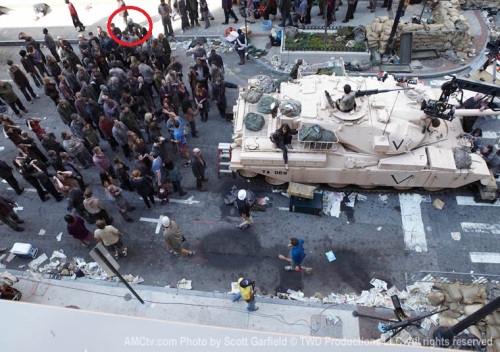
After breakfast (yes, the diner), I drove to the set and prided myself on being a few minutes early. That is when I realized that you really need to be there about an hour before your call time if you expect to make the cut.
Day Two was incredible. I knew of the significance of The Tank, from its prominence in the first two issues of the comic book. Little did I know what variation Darabont and Kirkman had cooked up for the show.
But what really worried me was the absence of Jack. Dangit, I thought to myself. Jack must have succumbed to the heat! The previous day was “hot as balls,” as Gary Whitta candidly observed. I was genuinely worried about Jack, especially since he had to wear a suit during the filming.
Preoccupied with Jack’s condition, I sat, moved, sat, moved, and eventually sat in one of the makeup chairs. After I was made up, sprayed, and reissued my mask, the group I was in was escorted to the holding area, and then on to the set -- and The Tank.
When I got onto the set, there was Jack! But not masked Jack. It was full-on, prosthetic made-up and contact-lensed Jack! He looks awesome! He proceeds to tell me that he had a 4:45 AM call time, and he is sitting around when Nicotero came into the holding area, scans the room, and says, “You, you, you, and (looking at Jack) – YOU – come with me.” They go outside and into the KNB Effects Group makeup trailer. Jack is motioned to sit in the last chair. It is Nicotero’s makeup station. Yes, Nicotero makes him up personally!
Jack says to Greg, “You know, there’s this older guy from Tallahassee, knows everything about the Walking Dead, and says you are the best in the world at what you do.”
I am so happy for Jack. He is going to have so much fun. If, and this is a big if, if he can see where the Sam Hill he is going. Those full-eye contacts are not made for seeing, just sayin’.
It is time to film the Horse Takedown Scene. We see the stunt horse wrangler (Tommy Turvey of Brooksville, Florida) and several other people we did not see yesterday. Turvey is dressed as Grimes, as he was the previous day during the crowd scenes. Joining Turvey for a pow-wow are a woman and two men, all in full Hero Zombie prosthetic makeup.
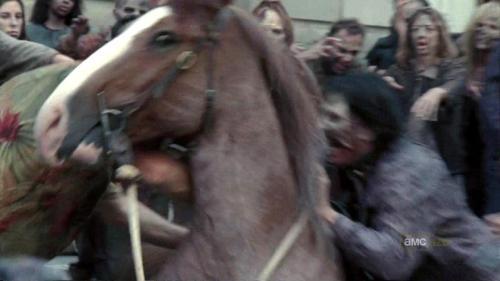
The rules for us are simple: Stay quiet and stay away from the horse! The plan is for the horse to fall down and roll over as the stuntmen and the woman wrangler gently coax the horse over. I notice two people with clipboards, intently looking the scene over. They are wearing golf shirts with the emblem of the American Humane Society on the front.
Then all is explained. The woman works with Turvey and very well may be his sister Karen Turvey-Marshall. The two men are professional stuntmen. One is from north Florida, and one lives on the Georgia-Alabama border.
We are to stay in the background as the professionals work with the horse. Then Darabont yells, “Action!” As planned, the horse rears. Turvey “falls” off the horse as the stunt men and the woman wrangler surround and then place their hands upon the horse. It is quiet as church while this happens. Then, the horse falls and rolls over, on command. Turvey makes a sound with his lips and the horse raises its head as if it is writhing in pain. We begin surrounding the horse from a safe distance. The stunt men and horse woman begin acting as if they are eating the horse. And the horse stays put and pretends to be writhing!
(In the picture above, I am at the extreme upper-right-hand corner, next to Michelle Flanagan-Helmeczy, who was kind enough to tag me in the photo.)
Darabont yells, “CUT!” and laughs maniacally! The horse takedown scene took one take. One take. Amazing. The horse is the best actor on the set.
It’s time to Chase Rick. All of us are around the tank. (I am in the extreme upper left corner). We do take after take, shambling around the bloody tank. Then we chase Andrew Lincoln under the tank. He is sweaty and he is dirty and his arms and hands are covered with asphalt pebbles, because they cannot use the fake pavement mat for these shots. He is working his fanny off and he is not uttering anything even remotely negative. He immediately earns major respect from the other actors, who are also sweaty and dirty and whatnot.
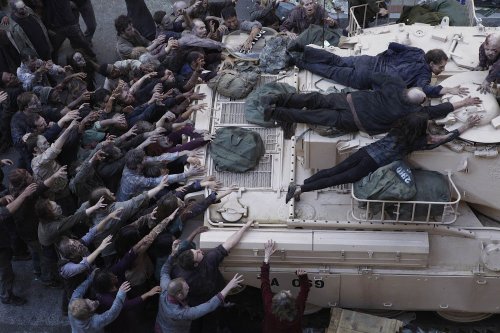 The light is overhead now, and they bring in some sort of diffusing screen that diffuses light, but is also translucent and silvery and it is hot Hot HOT under there. I retreat to the safety of the sunlight. I am bald and they have spray-painted my head with black paint, so there is zero chance my head is going to get burnt. I stand in the street between takes, arms extended, grateful for every breeze that makes its way down the avenue. And I am as happy as a zombie in body parts. I cannot believe I am doing this.
The light is overhead now, and they bring in some sort of diffusing screen that diffuses light, but is also translucent and silvery and it is hot Hot HOT under there. I retreat to the safety of the sunlight. I am bald and they have spray-painted my head with black paint, so there is zero chance my head is going to get burnt. I stand in the street between takes, arms extended, grateful for every breeze that makes its way down the avenue. And I am as happy as a zombie in body parts. I cannot believe I am doing this.
The crew keeps us hydrated and keeps us fed at lunch and I am marveling at the professionalism and the precision of the crew. I am an award-winning IT leader, and I appreciate excellent project management more than most. And I have to keep my head on a swivel, else I get run over by crew persons schlepping expensive equipment to and fro.
Between takes, I sidle up next to Purple Suit Zombie, who I later learn is makeup guy Joe Giles. Joe and I speak for several minutes, and he is marveling at the capabilities of one of the actors – a young and very pretty young woman who, in real life, only has part of one of her arms. She has crawled under the tank over and over again to chase Andrew Lincoln, and she has been an absolute trooper. Joe is especially impressed with her resolve. She makes the final cut of the pilot splendidly, snarling at Lincoln as she tries to eat him under the tank.
I also get to know the guy in the aqua cap better. He is a really, really good guy and we enjoy talking together.
Really? The bloody bag of guns cannot hit its mark! Say your lines, hit your marks, right? We have to redo a couple of shots because the bloody gun bag misses its mark.
Now it is much later in the day – about 7:00 PM or so, Sunday evening – and we are still filming. I know enough to realize we have to hurry or we’ll lose our light. The BIG SCENE is about to be filmed, you know what I am talking about.
The foam-rubber-and-wireframe horse is brought in. The American Humane Society people are still on set! I think, “Really? Really?” They soon leave. A PA positions me at the ass-end of the foam-rubber horse with cables coming out of its rear end. But the cables are not hooked up, because the horse’s head-bobbing and acting has rendered the pneumatic or electrical or whatever-it-is animatronics unnecessary.
This horse will wind up saving my life.
Suddenly, Darabont appears and starts telling us what to do. I am thinking, “My God, I am being directed by Frank Darabont!” However, I am in a mask, and a close-up is required. Greg Nicotero comes up beside Darabont and starts pulling people out of the shot who are without makeup, or persons wearing masks.
I look up and say, “Greg, do you need me out of the shot?”
He looks at me and, without hesitation, points to me as he says, “No, because I know how important this is to you. But keep your head up, because if I see the elastic, I will give you s—t.”
I decide then and there I will fall on a grenade for Greg Nicotero. I will take any bullet of any caliber, anywhere on my person. He remembered the conversation Jack had with him. He knew I was the guy. I am grateful beyond words.
Next up is the Money Shot, what we all have waited for! We are going to eat a horse! The horse has a flap. Nicotero appears with a bucket of stage blood and fake horse innards. He coats the innards with stage blood and stuffs the whole enchilada into the horse’s stomach flap.
Nicotero slathers my arms and hands with stage blood. A makeup person paints blood on my mask.
I am in Heaven. Zombie Heaven.
“And, Action!”
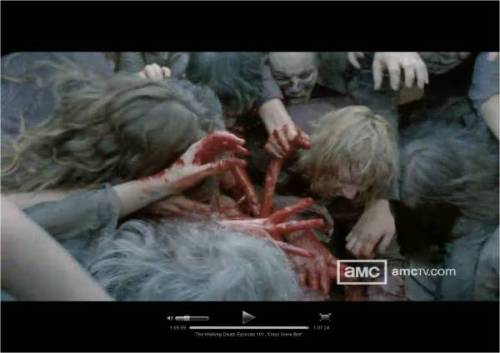
Now is the Zombie Mosh Pit. That is the shot where the camera will pull up and reveal the entire scene. The first take, I am on one knee, and the sheer wave of humanity catches me off-guard. I cannot move my right leg, and I am fearful that my back will break. I push back with everything I have and am the most grateful person on the set when Darabont yells cut.
We get that damn horse real good. A few more close-ups and takes, and that shot is done. For the record, I kept my head up. And I made the final cut, as you can see in the photo above.
I reposition my body so I am on both knees. We do about eight takes, and each time, I am using that foam horse to absorb all the weight of roughly ten people on my back. I love that horse.
 Now we are wrapped, and we all pose for a photo with Darabont and Robert Kirkman. I am in the back, and all that can be seen of me is a bloody arm. However, several of my zombie friends did make the photo, including Gary Whitta and Tim Daniel to the immediate left of Kirkman, and actors Melissa Cowan, Sonya Thompson, Michelle Flanagan-Helmeczy and Jack Byrd (far right) to the right of Darabont. And my upraised left arm, between Kirkman and Darabont.
Now we are wrapped, and we all pose for a photo with Darabont and Robert Kirkman. I am in the back, and all that can be seen of me is a bloody arm. However, several of my zombie friends did make the photo, including Gary Whitta and Tim Daniel to the immediate left of Kirkman, and actors Melissa Cowan, Sonya Thompson, Michelle Flanagan-Helmeczy and Jack Byrd (far right) to the right of Darabont. And my upraised left arm, between Kirkman and Darabont.
The actors are scattering toward the holding area, but I see Kirkman is alone in the middle of the street. I walk up and tell him how much I appreciate his work on the comics and how he writes with the eyes of a person much older then he actually is. He is genuinely grateful.
A handful of us are about ten feet from Darabont. Frank turns and says to us, “It was an honor to work with you.”
I looked right at him and said, “No, Mr. Darabont. The honor was all ours!” Darabont stands at attention and bows his head slightly, in appreciation. No wonder this guy is one of the best directors of our time. We would do anything for this guy!
We all have our gear and we are walking back to the dead restaurant staging area. We stop at a city square/park where there is a horse-drawn carriage. One of the female actors (I think it was Sonya Thompson) says, “Horrrrsssse.” The horse looks at us and moves uncertainly. I envision a runaway horse and carriage, chased by zombie extras. Blessedly, it does not occur. We’re all too tired.
It is time to change back into street clothing. The men are all changing in rooms on the mezzanine, and I run into the guy in the aqua ball cap. I say, “You know, we have been talking all weekend, and I do not know your name. Scott McPherson.” The guy smiles and says, “Tim Daniel. “
“Tim, we need to stay in touch. You are a great guy.”
“Yes, that would be great!”
My deep appreciation for Greg Nicotero was confirmed as the zombie actors, about 150 of us, all lined up to turn in our wardrobe. It’s about 8PM now, and I have a six-hour drive ahead of me. But I am not tired in the least. I am wondering what will happen when I stop for dinner on I-75 with my neck and arms looking like all the blood has pooled up in them. Then I notice Nicotero at the head of the line, shaking everyone's hand and thanking them personally for their work.
He stops at me and we talk, about what I have no clue because I am essentially speechless. But I am wearing a Bubba Ho-Tep T-shirt, and then I remember he was the effects guy for Coscarelli’s picture. I am sure he appreciated that.
When we were all in the wardrobe line, we hear a commotion coming from the street. We turn and see a small rental car, one of those ridiculously small subcompact cars. A large man in a Hawaiian shirt is driving and literally leaning out of the car, yelling “Hey! Great job, guys, great job! Thank you so much!”
It is Frank Darabont. OK, I can take two grenades. Just no head shots, eh?
Speaking of head shots: I have to drive six hours straight back to Tallahassee. Now I am so jacked that fatigue will not be a problem. But eating will be! I am still in makeup! I resolve to only hit the drive-through and gas up quickly. Even then, the looks I got…..
Postscript
Working on the Walking Dead was one of the four greatest experiences of my life. The other three include (IN ORDER) my marriage, the night I was elected to the Florida House of Representatives, and my one-hour flight in a P-51 Mustang (with twenty minutes of stick time).
The entire production crew was incredible, and they did a great job of feeding us, keeping us hydrated, and keeping us focused. Anyone who wants to work in project management should visit a movie or television set. The level of professionalism and dedication to excellence is an incredibly rewarding experience. I credit both Darabont and producer Gale Ann Hurd for that.
But by far, the greatest part of the experience was meeting great people and making friends with them. I have enduring friendships with some very talented Atlanta-based actors and actresses (do we still use that term?).
 Sonya Thompson is a local actor and is a “hero zombie” in several episodes. Her personage is frequently used in promos for the series worldwide. Her daughter is also a zombie actor!
Sonya Thompson is a local actor and is a “hero zombie” in several episodes. Her personage is frequently used in promos for the series worldwide. Her daughter is also a zombie actor!
 The face of The Walking Dead is Melissa Cowan, who is best known as “Bicycle Girl.” She, like Sonya and Larry, is red-hot on the comic convention circuit. She gets her own action figure soon!
The face of The Walking Dead is Melissa Cowan, who is best known as “Bicycle Girl.” She, like Sonya and Larry, is red-hot on the comic convention circuit. She gets her own action figure soon!
 Larry Mainland has appeared in several episodes, and, like Sonya and Melissa, appears frequently at horror and comic book conventions. That iconic photo of a zombified Larry getting out of a car in season one is one of the most tragic images from the show.
Larry Mainland has appeared in several episodes, and, like Sonya and Melissa, appears frequently at horror and comic book conventions. That iconic photo of a zombified Larry getting out of a car in season one is one of the most tragic images from the show.
 Steve Warren got a Hero Zombie’s death in episode 201, at the hands of Rick and his machete in the church scene. Steve recently moved to Sarasota, Florida, whereupon he sent me a message: "Moving to Florida to cancel out your vote!" I roared with laughter. Steve is a great guy.
Steve Warren got a Hero Zombie’s death in episode 201, at the hands of Rick and his machete in the church scene. Steve recently moved to Sarasota, Florida, whereupon he sent me a message: "Moving to Florida to cancel out your vote!" I roared with laughter. Steve is a great guy.
 So is Jack Byrd, who has had several appearances in different episodes. He’s climbed the tank; chased Glenn as he went for the bag ‘o’ guns; and got it in the eye from Shane in the aforementioned church scene.
So is Jack Byrd, who has had several appearances in different episodes. He’s climbed the tank; chased Glenn as he went for the bag ‘o’ guns; and got it in the eye from Shane in the aforementioned church scene.
Jack also had the distinction of being the "permanent guest": on AMC's phenomenal Talking Dead talk show! He was the mural that appeared frequently during cuts between Chris Hardwick and the guests. His picture was replaced by Madison Linz's zombie Sophia after the break. Heady company!

Ondie Daniel and Pamela Ashe-Smith were the first to befriend me on the set, are great actors and are great people as well. Ondie also does makeup and directs side projects.
 Pamela also volunteers for the Urban Mediamakers Association and Film Festival. She is one great lady.
Pamela also volunteers for the Urban Mediamakers Association and Film Festival. She is one great lady.
PLUG: Many of these people are connected with “Netherworld,” Atlanta’s haunted house. A secret: Zombieland, The Crazies and The Walking Dead all mined Netherworld for actors, makeup and effects people, and other experts. No wonder, then, that Netherworld is America’s Spookiest Haunt.

Michelle Flanagan-Helmeczy (pictured here with Charlie Adlard) has appeared in numerous episodes in Seasons One and Two. She is also pretty much guaranteed to work in Season Three, since she lives five minutes from the set! Lucky girl! She also spotted me in a photo that I somehow missed. She is great.
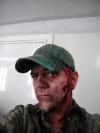 Last and absolutely not least, I have become fast friends with another extremely talented fellow named Tim Daniel, who has many duties with Image Comics and Skybound Entertainment. But that is not his day job! He is Webmaster for the University of Montana. He is involved in design work on several projects, perhaps the best-known being the smash Image Comic series named Morning Glories, and he is the author of the Walking Dead Survivors Guide.
Last and absolutely not least, I have become fast friends with another extremely talented fellow named Tim Daniel, who has many duties with Image Comics and Skybound Entertainment. But that is not his day job! He is Webmaster for the University of Montana. He is involved in design work on several projects, perhaps the best-known being the smash Image Comic series named Morning Glories, and he is the author of the Walking Dead Survivors Guide.
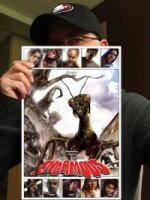 Tim’s greatest days clearly lie ahead as a creator and writer of comics. Tim, along with Moroccan artist Mehdi Cheggour, have created the graphic novella Enormous. Enormous deals with a post-apocalyptic Phoenix, Arizona, and giant mutated creatures called The Enormous.
Tim’s greatest days clearly lie ahead as a creator and writer of comics. Tim, along with Moroccan artist Mehdi Cheggour, have created the graphic novella Enormous. Enormous deals with a post-apocalyptic Phoenix, Arizona, and giant mutated creatures called The Enormous.
But even in an environment such as that in Enormous, the most dangerous creature is Man. And in this case, that villain is James Coyle. And Tim has cast me as a comic book villain!
 Life is good, folks.
Life is good, folks.
Diary of a Walking Dead Zombie, Part One (of Three)
Faithful blog reader:
As you may recall, I was fortunate enough to have been a zombie extra for the pilot episode of AMC Network's The Walking Dead.
I have wanted to tell about my experiences, because I had so much fun, but also, with the Dead Week upon us (defined as the celebration of Issue #100 of the comic book, plus the coming of San Diego Comic-Con). So here, in three parts, is my Diary of a Zombie: My Experiences as a Zombie on the Set of The Walking Dead. Parts One and Two will run Thursday, July 12th. Part three will run Friday, July 13th (get it? Friday the 13th!).
Preface
To say that I am a fan of the zombie genre is to say that the Grand Canyon is a pretty rock formation. I am a massive zombie fan. As far back as I can recall, the idea of the undead walking has had a great allure to me. I never liked those early, 1940s-era zombie films, though. White Zombie and the others, with their voodoo mystique, really did not do it for me.
What did do it for me was a 1950’s film, Creature With the Atom Brain. It had Richard Denning. It had a Nazi mad scientist in a cool lab. It had gangsters. It had dead cops walking! It had everything a kid with a fertile imagination would want.
But, as so many others have said over the years, the reinvention of the zombie mythos, served up ghoulishly by George A. Romero, was the coup de grace. I actually saw Dawn of the Dead before I saw Night of the Living Dead. I was in Connecticut with my then-girlfriend, and Dawn had just come out. I became a Romero fan right then and there, for life.
I had the great good fortune to meet Mr. Romero, back in the late 1970s, at Florida Atlantic University in Boca Raton. He was brought in to lecture and after the event was over, I introduced myself and asked him, among other things, why his protagonists were always black men. I was fascinated and impressed that Romero would cast such good young black actors in those pivotal roles. He shrugged and said, essentially, that he had no answer. I respected that, and I know his answer to that question today is much more thought-out and refined, and countless articles and blogs have been written about that question. I still like his personal response to me the best.
Zombie fans will go to great lengths to find material to watch and read. We are a very forgiving lot, and we will sit through absolute drivel to try and find diamonds in the rough. And those diamonds are rare: Shock Waves, filmed around Miami with underwater Nazi zombies; the Fulci Italian zombie movies, always enjoyable; and a few others. But there have been quite a few stinkers too! My video library is stocked with zombie cinema that did not quite make the cut.
I also used to collect comic books when I was a kid. I had to sell off quite a collection when my family moved in 1970. I tried to restart those collections twice in the 1980s, but it was not until I read Watchmen two years ago (in preparation for watching the movie) that I dove headfirst back into comics.
And that was when I found The Walking Dead. It truly was comics love at first sight. “The zombie movie that never ends,” as creator and writer Robert Kirkman calls it. I started reading where many people now begin their collections: the Walking Dead Compendium, a gargantuan, 1100-page softcover behemoth covering the first (and most pivotal) 48 issues of the comic.
It was brilliant. It was a revelation. And, like all great zombie fiction (whether written or filmed), it is all about the survivors – not the zombies – that makes great zombie entertainment. And Kirkman makes us care about survivors like no other. He makes us like them, and then he kills them!
Shortly afterward, I learned of the planned adaptation of the comic books to television.
And so it was that, one morning in May of 2010, my deputy CIO, Lauren Perlman, came into my office at the House of Representatives.
“A good friend of mine just got hired as an important member of the crew for a new series AMC was shooting,” she said. “Something called: ‘ The Walking Dead’.”
“THE WALKING DEAD?!?!?!” I shouted. “THE WALKING DEAD?” I said, “Lauren, I have got to be a zombie on that show!”
Roughly two weeks later, I got a call from Patrick of Extras Casting Atlanta, the go-to casting agency for television and film production in Georgia. Think Zombieland. The Crazies. X-Men: First Class. And The Walking Dead. Patrick called to get my email address so they could forward the information on where to report for sign-in, along with my date and “call time” when I was due on the set. My shoot was for the weekend of June 12th and 13th, 2010. That was perfect, as it did not interfere with my day job as CIO (that’s head geek) for the Florida House of Representatives.
As you might imagine, Lauren is now set for life.
I had never been in a movie before. My filmmaking experience was confined to watching the filming of a scene for the Chuck Norris film Invasion USA back in the 1980s. However, because of my different positions over the years in my “day jobs” within politics and government, most recently as an expert in pandemic preparedness (imagine that), I have appeared on television roughly a hundred times. I have been on NBC News, CNN, Fox News, CBS News, ABC News, and way too many local newscasts to even try to count. That gave me an appreciation for what I was about to do.
So I entered the situation with a completely blank canvas upon which to paint my recollections and to learn and absorb as much as I could during the two days I was there.
I decided to rent a hotel room as physically close to the shoot as possible. Even before the casting company had sent my confirming email with map, I had been able to scope out the details of the shoot on the Internet. I chose the closest hotel to the shoot itself – well, the closest hotel that was not going to cost me an arm and a leg (har!). That hotel wound up being two blocks from the set as the crow flew, but with the street closures, it still took me about 5 minutes to drive there.
I arrived in Atlanta that Friday night. The drive was problematic, as I ran over a shredded recap tread going northbound on I-75, about an hour south of Atlanta. After pulling off the interstate to inspect the situation, I kept going and pulled into a Truett’s parking lot in the southern suburbs of Atlanta to eat and to make repairs. The plastic shield underneath the oil pan had been knocked almost completely loose, hanging by a grommet. Also, one of my fog lights had been pushed in about an inch, but was still functional. I made emergency repairs, ate at Truett’s (Chick fil-A’s fancier sibling), and pushed onward.
After checking into the hotel, I decided to take a walk. I got as far as a burned-out bus, guarded by two policemen. My anticipation grew. Only my fatigue from the six-hour drive enabled me to sleep that night.
“Contagion” is a Deeply Unsettling, Haunting – and (Mostly) Realistic – Pandemic Film
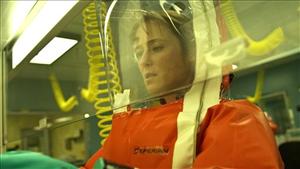 Those of us who have made pandemic preparedness part of our curriculum vitae could not have been more excited about the premiere of Steven Soderbergh’s latest film, ““Contagion”.”
Those of us who have made pandemic preparedness part of our curriculum vitae could not have been more excited about the premiere of Steven Soderbergh’s latest film, ““Contagion”.”
And we were not disappointed. “Contagion” is a paragon of what an intelligent biological thriller should be: hyper-accurate, absorbing, and, most of all, a film that reminds us of our own individual responsibilities within a civilized society.
Not to say that there’s not a little bit of Hollywood in this film. More on that later. First, let’s take a look at how the movie was made, the etiology of the fictional virus, and what Hollywood got right. And in many cases, they got it absolutely right.
What “Contagion” got right
The MEV-1 virus in the movie is the brainchild of Dr. Ian Lipkin, of Columbia University. Dr. Lipkin directs the Center for Infection and Immunity at the Mailman School of Public Health at Columbia. He was contacted by Soderbergh and the film’s writer, Scott Z. Burns. He agreed to come on board the production as a paid technical and science adviser.
Dr. Lipkin created a virus for the film that is patterned after an actual virus: The Nipah virus. Nipah was first discovered in Malaysia in 1999. The natural reservoir of Nipah is in the Malaysian fruit bat population. The WHO reports that Nipah has also been found in bat urine and in partially-eaten fruit in the region. Oh, by the way: The real-life bats in question are migratory. Toward that end, antibodies to a virus very similar to Nipah have been found in India, Indonesia and Timor.
There is a danger in making bats the heavy in the film. Bats are essential in such areas as insect control. And North American bats are dying by the millions, due to “white-nose syndrome,” a fungal infection that essentially suffocates bats during their annual hibernation.
But bats are also vectors of some of the world’s most dangerous diseases, especially Ebola – and SARS.
While the MEV-1 virus is patterned after Nipah, the pattern of infection is modeled after the SARS virus. How quickly we forget how threatening SARS really was. In bookstore remainder bins all over the continent, one can find Karl Greenfield’s seminal work on the SARS epidemic, titled, “ China Syndrome: The True Story of the 21st Century's First Great Epidemic.” I highly recommend his book.
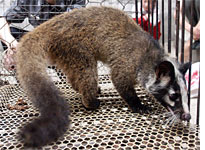 While the original vector of SARS in 2002/03 was a “civet cat,” a peculiar-looking mammal, it may be that the civet cat in question was infected by a bat. SARS virus has been found in Brazilian bats, so the danger is not localized to Southeast Asia by any means.
While the original vector of SARS in 2002/03 was a “civet cat,” a peculiar-looking mammal, it may be that the civet cat in question was infected by a bat. SARS virus has been found in Brazilian bats, so the danger is not localized to Southeast Asia by any means.
Had SARS been more like influenza and less like the common cold, we would have seen a pandemic that would have made 1918’s Spanish Flu look like the common cold. In the US, the H1N1 Spanish Flu pandemic killed 2.5% of everyone it infected. In contrast, SARS killed 10% of those it infected, worldwide. But luckily for us (“us” being the world), SARS infected so quickly, public health professionals got in front of the disease and eventually beat it down. It is counterintuitive to be sure, but a disease that infects quickly is easier to corral than one with a days-long incubation period, such as influenza.
To go into how SARS infected and killed would also produce those obligatory “SPOILER ALERT!!” warnings and disclosures, which I want to avoid (where possible) in this review. So suffice it to say that “Contagion” is disturbingly accurate when it comes to how quickly it was able to infect on a global scale.
SARS was not the exclusive province of China, Toronto or Singapore. Two prominent Tallahassee residents (who I obviously cannot identify for HIPAA reasons) were infected by SARS during a visit to China in 2003. The CDC and WHO were actually monitoring their health following their return to Tallahassee. By proxy, they were monitoring Tallahassee for signs of SARS infection.
So what Soberbergh, Burns and Lipkin created were a perfect fit of an established disease and historic established routes of transmission. In other words, extremely realistic.
Dr. Lipkin also taught the cast how to correctly don protective gear, and how to speak the language of disease.
In the movie, the Elliott Gould character, Dr. Ian Sussman (yes, a probable nod to Dr. Ian Lipkin) is able to finally grow a sample of MEV-1 to produce a vaccine candidate. This storyline parallels the first attempts to grow H5N1 in chicken eggs to produce a vaccine. Bird flu was killing the eggs. That was eventually overcome. Of course, H5N1 poultry vaccines have arguably done more harm than good, but that is a matter left to my previous blogs on the subject.
Elliott Gould’s Dr. Sussman is handling the virus in a Level 3 lab, and the CDC has already ordered all samples not contained in a Level 4 lab to be destroyed by fire. Dr. Sussman’s on-screen disregard for CDC protocols is reminiscent of the spanking that real-life Dr. Yoshihiro Kawaoka of the University of Wisconsin received in 2007 for handling “copies” of the dreaded Ebola virus in a level-2 lab.
Laurence Fishburne’s admonition that “We don’t want that virus leaving on the bottom of someone’s shoe” refers to a frequent and ongoing concern. For more information, refer to my ongoing blog series, “When labs attack.”
What “Contagion” could have done better
Where the movie deviates from probability, in this reviewer’s opinion, is in its depiction of how society would react to the virus. These deviations are all permitted, because they are clearly possible. It is just in the areas that were left out that very minor – and forgivable – faults can be found.
In less than a month, society pretty much goes over the cliff. Garbage lies uncollected and strewn about neighborhoods. Unions strike, rather than perform their duties. Governors call out the National Guard and seal borders without apparently seeking consultation from Washington. And while grocery stores are ransacked and food is extremely scarce, the lights and phones somehow stay on.
The Enemy of the People in any pandemic is the stability of the supply chain. That just-in-time supply chain is the most fragile part of our economy. The level of global apprehension, not to mention the Case Fatality Rate of the MEV-1 virus in the film, would have produced much more damage to the global supply chain.
Those of us who are sought-out as experts in pandemic preparedness often point to unions as a cause for concern. In fact, pandemic planners factor in possible union (in)actions in their calculations, but I believe that people are also capable of doing heroic things. The public health experts in “Contagion” are justifiably viewed as heroic. But as we saw on 9/11, and as we were reminded this past weekend, heroism is not limited to one exclusive group of people.
However, the images of public employees such as law enforcement officers abandoning their posts in New Orleans during Katrina – and even joining in the looting and pillaging, in a few cases – is also testament to our individual faults and failings. That, too, can be seen in “Contagion,” even at the higher levels of the government.
The film did not damage the critical infrastructure enough. In a prolonged, 1918-type pandemic, we believe ports will clog, phones will become unreliable, and power will come on and off – all because there will not be sufficient levels of people healthy enough to work to maintain them, nor will there be sufficient numbers of people to work, due to absenteeism to take care of loved ones. And there are always those who will burn sick days just for a headache. We have estimated that, at the height of a pandemic, as much as a third of the workforce might be absent on any given workday.
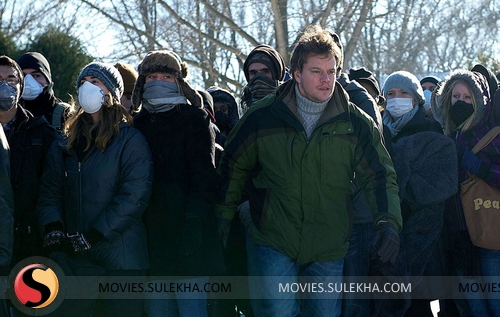 The movie attempts to display the deterioration of society in a few select scenes, but the film did not go far enough in its depiction of the degradation of the infrastructure. It did show the requisite looting of grocery stores, and certain unsettling acts of violence, and it did an excellent job in its frequent shots of uncollected refuse.
The movie attempts to display the deterioration of society in a few select scenes, but the film did not go far enough in its depiction of the degradation of the infrastructure. It did show the requisite looting of grocery stores, and certain unsettling acts of violence, and it did an excellent job in its frequent shots of uncollected refuse.
In a real-life, lethal pandemic, the military would be called upon to perform these tasks. That would include the National Guard, which I must believe would be Federalized early on, in order to prevent the types of actions that were undertaken by individual governors as the pandemic worsened. Federalizing the Guard places those units under the direct control of the Pentagon. Governors lose their Guard in that scenario. I would have to believe that the president would exercise that authority very, very early on in this process.
Sealing the borders, for example, has been almost completely tossed as a realistic countermeasure. The SARS epidemic and the H1N1v “swine flu” pandemic showed how border closures would be ineffective to restrain any virus.
This point (along with the supply chain issue) was actually done very well in the TV-movie “Fatal Contact: Bird Flu in America”. In that film, the military is called home from Iraq and Afghanistan to help maintain law and order. I would expect governors to call all their Guard units home, to assist in stabilizing the infrastructure of their states and to curtail inevitable violence.
Other than the depiction of labor unions as petty and self-serving, “Contagion” also serves as a confirmation of the Second Amendment during a crisis. Cops are not around when the shooting starts. Self-defense is the order of the day. Being armed equals being safe. These are two curious messages to be dealt by a Hollywood director, and I found it to be refreshing.
SPOILER ALERTS COMING!
My family felt that it was a little preposterous that key public health people would not continuously wear their masks and gloves, especially in public. We have had many discussions regarding the efficacy of wearing masks in public, however, and I defer to the writer and director on this topic.
Another concern (the most deeply-rooted one) is in the film’s conflict between the CDC and the Minneapolis public health unit. This is where the Hollywood formula kicks in, resembling a Criminal Minds episode where the local cops resent the FBI intrusion into their bidness. The reality is that local public health units generally work very well with the CDC, and welcome their participation when things go bad. In my experience, the CDC is a first-rate organization, led by top-flight people. Local public health units do the best they can do, especially in this current economy, but “overwhelmed” would be an understatement on any given workday – let alone during a pandemic.
Dr. Michael Osterholm, head of the Center for Infectious Disease Research and Policy at the University of Minnesota (and who worked at the Minnesota Department of Health for a quarter-century), alluded to this during a recent “Contagion”-inspired interview. In fact, the Minnesota Department of Health is one of the best-run departments of its kind in the country.
The other area that the movie (which runs a brisk 106 minutes) glosses over is within the subject of vaccine production. Public health experts such as Dr. Osterholm have stated that the movie’s scenario for vaccine production is too rosy (my words). Vaccine production takes months, even in a “good” viral situation such as producing an influenza vaccine. It took every bit of six months just to produce the swine flu vaccine.
With a new and previously-unseen virus, especially considering the repeated failures of the prototypes, it would take considerably longer. The wait for vaccine could take almost a year, causing further destruction of the global economy and the further erosion of the critical infrastructure. And this does not even deal with the issue of who gets vaccine and who does not.
In another “Contagion”-imitates-life example, a Chinese group has kidnapped a WHO official, and demands -- as ransom -- vaccine produced in the West. This is a nod to the possibility of natively-produced substandard or even counterfeit vaccine. It is nice to hear someone demanding America vaccine –anything – because it is the best in the world. Note, at the end of the movie, the architecture of the open-air school housing the Chinese children.
The vaccine issue is personalized within the village, but once again, the script alludes to larger global issues. In this case, the rural, poor demand for vaccine speaks to the problems caused by Indonesia in the fight against bird flu. Back in 2007, the Indonesian government refused to share human bird flu samples – or even to quickly report human bird flu cases and deaths – simply because they felt their samples would make the global pharmaceutical companies billions of dollars, and, at the end of the day, leave Indonesia without any vaccine. It took years for the West to negotiate an agreement with Indonesia to give them vaccine in exchange for human bird flu samples.
The movie did do a good job of showing the agony involved with waiting and waiting until their vaccine lottery number was called. I found the prospect of a “vaccine lottery” to be a curious and interesting (and fair) way to resolve the issue of who got vaccine and when. The reality is, there is a schedule of who gets vaccine, at least within the first responder community, the military and the government. The Strategic National Stockpile has the goods. The Department of Homeland Security and state governments have the plans. After that, I doubt if there is a plan, so the lottery idea seems as fair as any.
Finally, we need to address the issue of the blogger character played by Jude Law. “Blogging is graffiti with punctuation,” Elliott Gould admonishes Law’s character. Law’s Alan Krumwiede is the worst sort of blogger, one who is only interested in promoting his “brand” at the expense of the truth, not to mention people’s very lives, by promoting an unproven homeopathic “remedy.” He is the 21st Century snake oil salesman, shamelessly hawking an elixir that is eventually proven to be dangerously ineffective.
Fortunately, I do not know any bloggers personally who would fit into those shoes. My disease-blogger friends are all dedicated people who, in their minds and in mine, are performing a valuable service by alerting their readers to some very real threats and dangers. Their surveillance uncovered the swine flu pandemic before the world’s press did, and their work on tracking H5N1 has proven to be extremely accurate. I hope Law’s Krumwiede would not get the attention he gets in the movie. However, having sat numerous times where Law’s character sat, in a quiet studio, in front of a television camera with an IFB in my ear, talking to a reporter or a network news anchor, I can understand how a marginal “playa” could become a fiend, mainstreamed by the press. It is up to the individual to censor him/herself and to produce accurate content.
Summation
““Contagion”” is an incredibly well-researched, disturbingly plausible, and extremely well-made film. With the exceptions of the vaccine production timetable and the downplaying of the damage to the economy and the critical infrastructure, Soderbergh and Burns got it right. Soderbergh is his own cinematographer as well (under a nom de plume), and his use of “available light” in place of standard movie lighting techniques makes the film feel much more realistic -- which means, of course, much more disturbing. The cast, without exception, is fantastic. Gwyneth Paltrow factors heavily throughout the film, so her apparent quick departure in the film’s first act is compensated for throughout the movie.
And equally exceptional is the villain, the MEV-1 virus. The fact that it is based on a real virus should wake us all up to the need to engage more strenuously in personal hygiene, and remember the things Momma taught us:
- Wash your hands frequently.
- Cover your cough, not with your hands, but with your sleeve, or a handkerchief or napkin.
- Keep a respectable distance from strangers.
Now go put on your Level 4 gear and go see the movie!
Here are some other sites, in case you want more “Contagion” stuff:
Mike Coston’s superb Avian Flu Diary, and his entry on the movie.
http://afludiary.blogspot.com/2011/09/why-you-should-catch-”Contagion”.html
An interview with Dr. Mike Osterholm on the accuracy of “Contagion”:
http://www.startribune.com/lifestyle/wellness/129464038.html
And a dynamite Wired blog, written by the extremely talented Maryn McKenna, featuring an interview with Dr. Ian Lipkin. Maryn has two books in print that hypochrondriacs should not read. Her latest is on MRSA and it is called Superbug. Find it at your local bookstore, if one still exists, or order it from Amazon.
http://www.wired.com/wiredscience/2011/09/”Contagion”-questions-spoilers/all/1
Last, and least, an article on “Contagion” from a Palm Springs, California newspaper, with some quotes from yours truly.
http://www.mydesert.com/article/20110911/NEWS01/109110341/-”Contagion”-not-far-fetched
"We just need to make sure that nobody knows, until everybody knows" -- enjoy these clips from "Contagion"
The entertainment Website Filmonair.com has put up some clips from the Steven Soderbergh disease thriller "Contagion." enjoy them and listen to A-list actors deliver such lines as "social distancing" and "Congress is figuring out how to work online."
